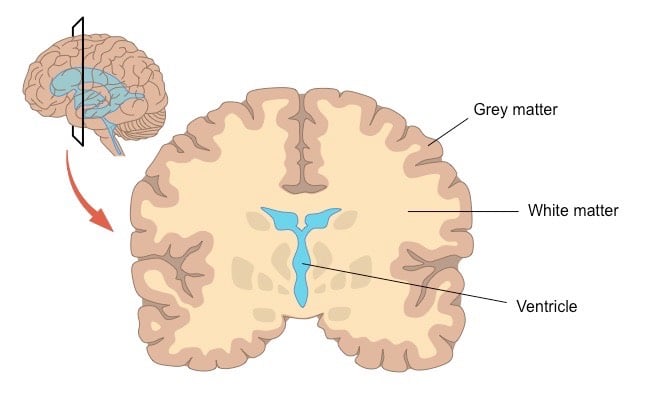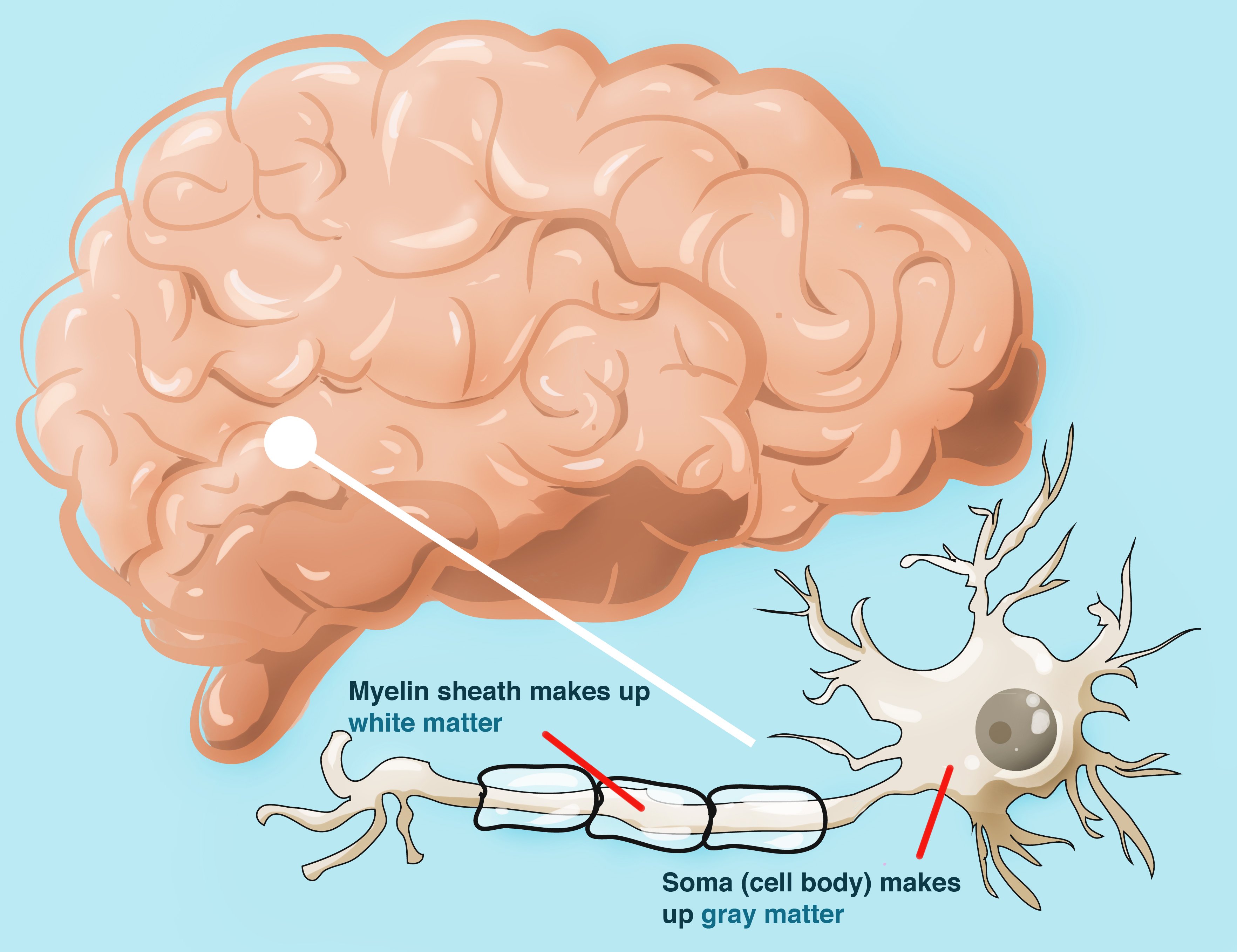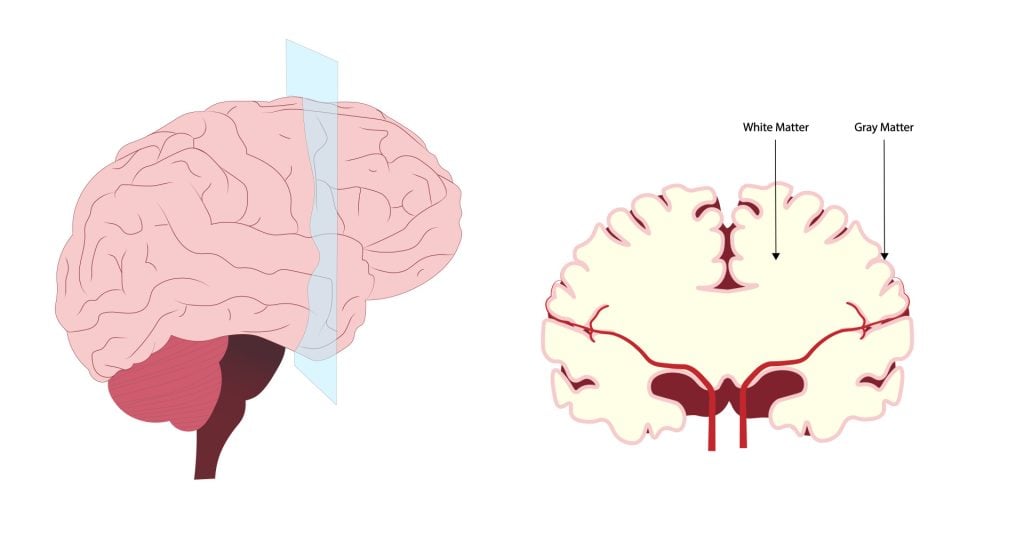On This Page:
The central nervous system (CNS) is made up of tissue known as white matter and grey matter. White matter makes up around half of the brain and comprises bundles of millions of axons (or nerve fibers).
White matter is located in the deep parts of the brain while gray matter makes up the outer surface of the brain. White matter essentially acts as the brain’s communication network, connecting different parts of gray matter and facilitating coordinated brain function.

White matter, or substantia alba, refers to neural tissue in the form of densely packed bundles of myelinated nerve fibers, typically found in the brain and spinal cord. This structure allows for rapid transmission of neural signals between brain regions.
As the name suggests, white matter is white in color. The white appearance is a result of the white-ish fatty substance which surrounds the axons, called myelin sheath.
White matter is organized into tracts of axons and also consists of glial cells, which support the neurons and produce myelin. In the brain, white matter is found beneath the grey matter, in the deeper tissues, making it subcortical.
Grey matter, which makes up the other half of the brain, is the outermost layer of the brain, which consists of neuronal cell bodies and unmyelinated axons. White matter is found in the cerebrum and cerebellum subcortically.
It is also present in the spinal cord, but it instead surrounds the grey matter, which is located in the center. Whilst grey matter is the tissue where the ‘processing’ takes place, the white matter is where the ‘communication’ takes place.
The role of white matter is to allow information to be transmitted between different areas of the grey matter within the CNS. Unlike grey matter, which peaks during child development, white matter keeps developing until the later 20s, with some areas in the CNS taking longer to develop than others.
What White Matter Consists of
White matter consists of millions of bundles of axons, or nerve fibers. Axons are portions of the nerve cell (neuron) that carries nerve impulses away from the cell body.
Axons are long slender-like structures that extend away from the cell body. The axons that make up the white matter are covered in a white substance called myelin sheath.
Myelin sheath is a sleeve of fatty tissue that insulates the axons and gives white matter its white appearance. Myelin works to insulate the axons of the nerve cells to ensure a higher speed of transmission of electrical signals.

Myelinated nerves can carry electrical impulses up to 100 times faster than non-myelinated nerves, so if they were to be damaged, this could impact sensory, motor, and cognitive functions.
Myelin sheath is made by the types of non-neuronal cells which are also present in the white matter, called oligodendrocytes. These types of cells are known as glial cells, which are cells that provide support or protection to the neurons. Oligodendrocytes form the myelin and wrap this around the axons up to 150 times.
All the layers of myelin are tightly compressed around the axon to ensure it is protected. On the axon, there are gaps in the myelin sheath called nodes of Ranvier.
These unmyelinated gaps cause the impulses traveling along the length of the axon to leap from node to node. When it does this, the signal increases in velocity so it can reach its destination quicker than traveling down the axon without nodes.
At birth, myelin coverage is relatively sparse and begins in the white matter nearest the nape of the neck. Gradually, myelination occurs forwards over time until finally coating the frontal lobes when humans reach their mid to late 20s.
Function
White matter in the brain comprises myelinated axons that facilitate rapid transmission of neural signals. Its primary function is to connect different brain regions, enabling communication and coordination between them.
White matter essentially affects learning and brain functions, modulating the distribution of action potential, and coordinating communication between the different brain regions.
Human brain imaging scans, specifically magnetic resonance imaging (MRI), have found structural changes in white matter after learning complex tasks. For instance, there was a correlation found between the number of hours a professional musician practices and structural changes in their white matter.
The amount of change was proportional to the number of hours the individual practiced. The greatest changes were observed in parts of the brain that were not fully myelinated yet.
In a study of adults learning to read, there were significant increases in the volume, anatomical organization, and functional connectivity of white matter tracts in the regions of the brain associated with reading (Fields, 2010).
Another study used diffusion MRI, a technique that can observe the microstructural properties and organization within the brain tissue depending on the dispersion of water molecules.
They used this method to study the white matter in adults with poor or normal reading abilities. It was found that those with decreased reading ability had decreased diffusion in the white matter of the temporoparietal area (Klingberg et al., 2000).
This difference in white matter tracts may contribute to reading ability through determining the strength of the interaction between cortical areas involved in visual, auditory, and language processing.
Overall, these observations imply that learning a new skill is associated with white matter structure. Another study found an association between white matter structure and IQ (Schmithorst, Wilke, Dardzinski, & Holland, 2005).
Through the use of diffusion MRI, the researchers found that many cognitive functions correlated with greater axon organization, specifically in the frontal and occipital-parietal association areas.
The corpus callosum is the largest white matter structure in the brain which connected the left and right cerebral hemispheres. In a study of children who have experienced abuse or neglect, the corpus callosum was found to be 17% smaller in these children than in those who had not experienced abuse (Teicher et al., 2004).
This study suggests that early childhood experiences can affect the development of white matter.
In terms of myelination, it has been found that the length of time myelination takes to fully develop (until humans reach their mid to late 20s) lines up with the same period of time when the cerebral cortex undergoes a restructuring of synaptic connections.
This remodelling is understood to modify the brain according to experience. Thus, some researchers believe that myelin and white matter play a role in shaping the brain through our experiences as we develop.
Associated Disorders
There are several conditions that can disrupt the vital connections in white matter, which can be a serious issue. Multiple sclerosis is a condition whereby the myelin in the white matter gets destroyed, resulting in motor or sensory disruption.
Some of the symptoms of multiple sclerosis are fatigue, difficulty walking, numbness, and muscle spasms. In progressive multiple sclerosis, damage to the axons is followed by irreversible neuronal death. Another myelin-attacking condition is Guillian-Barré syndrome.
When this destroys the myelin, it can cause muscle weakness, reflex loss, numbness, and tingling sensations in parts of the body. Eventually, this can worsen and can result in paralysis.
White matter hyperintensities is a term used to describe spots in the brain that present as bright white areas on magnetic resonance imaging (MRI) scans. This is often referred to as white matter disease.
The hyperintensities are as a result of decreased blood flow in those areas. The blood vessels harden and prevent oxygen and other nutrients from reaching the white matter.
The presence of white matter hyperintensities has been correlated to a higher risk of stroke, which could result in vascular dementia. Some of the risks associated with white matter disease could be age, blood pressure being too high, smoking, cardiovascular disease, and high cholesterol.
Spinal cord injuries can also affect white matter’s function. If damage occurs, for instance, by trauma to the spinal cord, this can cause the axon bundles to be damaged.
The connection between the brain and the grey matter in the spinal cord is then lost. This can lead to paralysis and sensory issues, which are often permanent if the neuronal bodies are also damaged.
Some studies have found that there may be a link between changes in myelin and the following conditions: Autism, posttraumatic stress disorder (PTSD), attention deficit hyperactivity disorder (ADHD), depression, and obsessive-compulsive disorder (OCD), suggesting that white matter may play a part in many mental health and developmental conditions.
Schizophrenia has been linked with white matter. Studies have shown that the white matter tracts across the majority of the brain are disrupted in those who have schizophrenia. A theory for why this may be that schizophrenia typically develops during adolescence when the forebrain is given its myelin coating.
Likewise, studies have found that white matter may play a role in the development of Alzheimer’s disease. Abnormalities in white matter have been found prior to the development of Alzheimer’s.
As well as this, the presence of white matter lesions has been found prior to mild cognitive impairment, a condition that increases the risk for Alzheimer’s disease.
How to Strengthen White Matter
For white matter disease specifically, there is no cure, but there are treatments that can be used to manage the experienced symptoms. Physical therapy is a common treatment that can help with any balance or walking difficulties someone may develop.
Similarly, managing vascular health could also be an effective way to manage symptoms of white matter disease. Not smoking and regulating blood pressure (e.g., through blood pressure medications) may help to slow the progression of the disease.
To strengthen white matter, there is support for the use of physical exercise, especially aerobic and weight resistance training. Physical exercise has also been linked to decreasing the likelihood of developing conditions with cognitive decline, such as dementia and Alzheimer’s.
As evident from the previously discussed neuroimaging studies, learning a new skill appears to positively influence white matter. A suggestion to strengthen white matter could be to pick up a new skill, such as learning to play an instrument or learn a language.
Completing relaxation exercises such as meditation or mindfulness training has also been suggested to strengthen white matter functioning. Studies have found that completing two to four weeks of meditation practice was enough to observe differences in white matter.
Finally, methods of protecting the brain from damage are also ways to decrease the risk of white matter dysfunctions.
Avoiding large amounts of alcohol so that balance is not impaired can decrease the risk of falls and damage to the brain and spinal cord.
Also, ensuring a helmet is worn when completing activities such as cycling also minimizes the risk of damage to the brain.
References
Fields, R. D. (2010). Neuroscience. Change in the brain’s white matter. Science (New York, NY), 330(6005), 768-769.
Klingberg, T., Hedehus, M., Temple, E., Salz, T., Gabrieli, J. D., Moseley, M. E., & Poldrack, R. A. (2000). Microstructure of temporo-parietal white matter as a basis for reading ability: evidence from diffusion tensor magnetic resonance imaging. Neuron, 25 (2), 493-500.
Newman, T. (2017, August 16). White matter: The brain’s flexible but underrated superhighway. Medical News Today https://www.medicalnewstoday.com/articles/318966
Schmithorst, V. J., Wilke, M., Dardzinski, B. J., & Holland, S. K. (2005). Cognitive functions correlate with white matter architecture in a normal pediatric population: a diffusion tensor MRI study. Human brain mapping, 26 (2), 139-147.
Teicher, M. H., Dumont, N. L., Ito, Y., Vaituzis, C., Giedd, J. N., & Andersen, S. L. (2004). Childhood neglect is associated with reduced corpus callosum area. Biological psychiatry, 56 (2), 80-85.


